BOLD TENDENCIES 2022 LOVE
Martin Creed
Rhea Dillon
Nan Goldin
Paloma Proudfoot
Dominique White
Gray Wielebinski
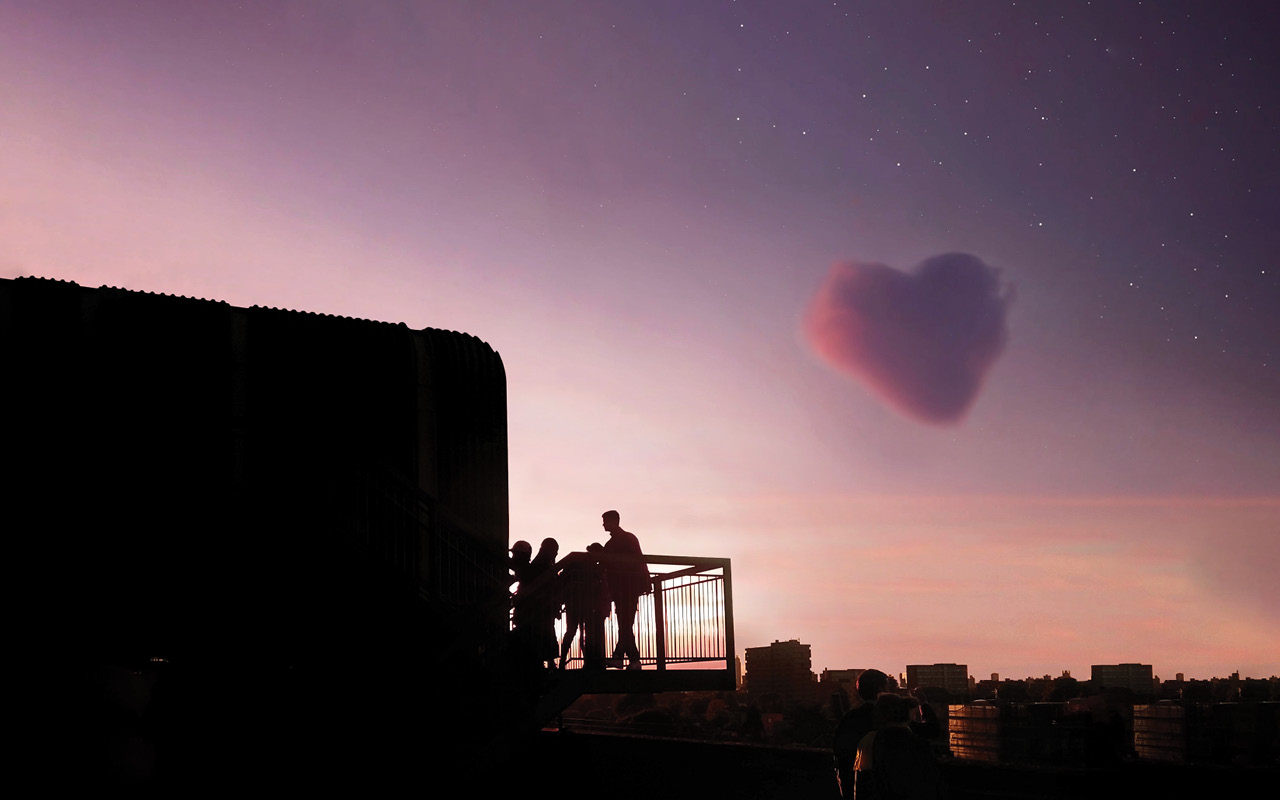
Martin Creed
Rhea Dillon
Nan Goldin
Paloma Proudfoot
Dominique White
Gray Wielebinski
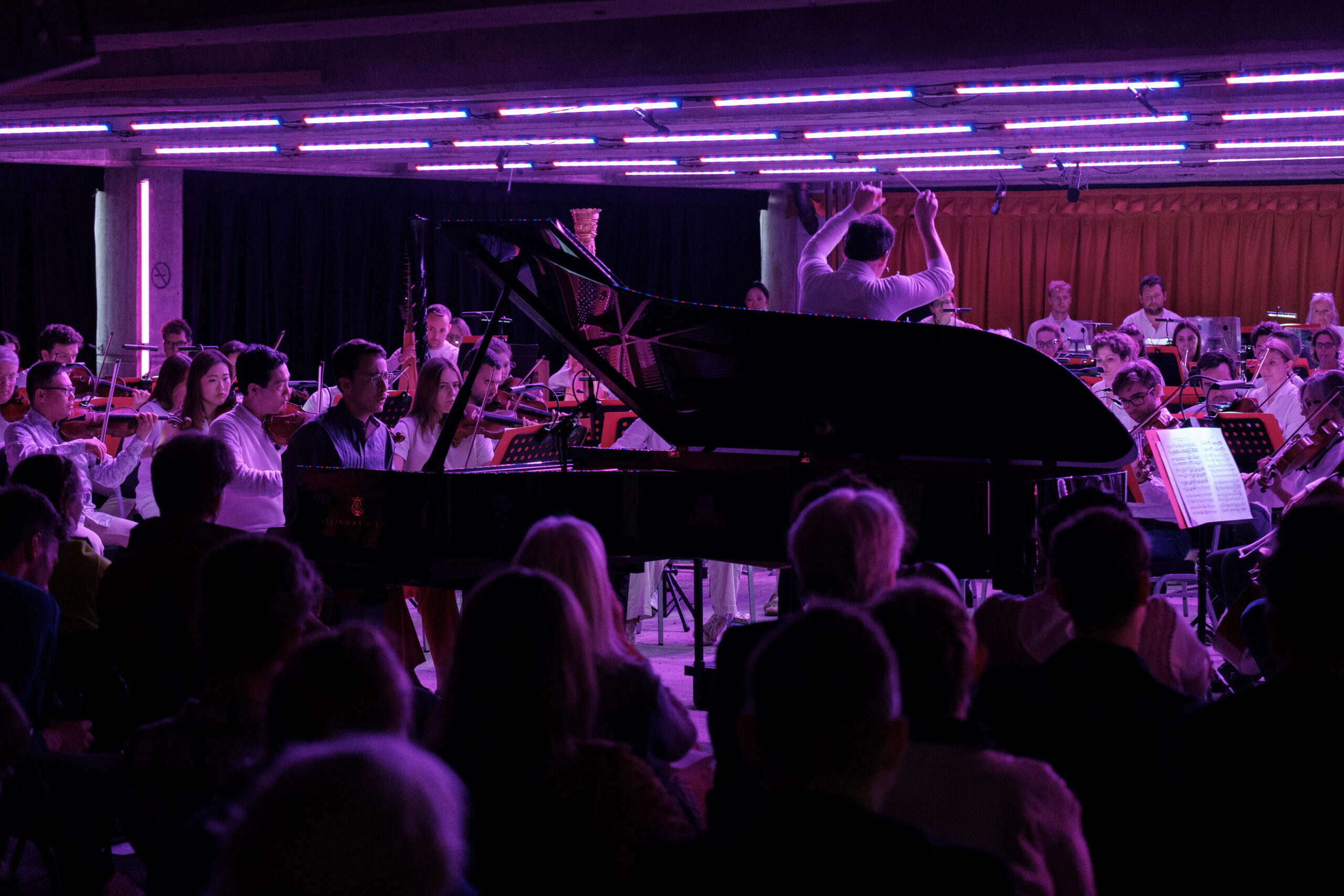
Samson Tsoy & The Philharmonia Orchestra — 04/06
The Multi-Story Orchestra — 09 & 10/06
Caleb Femi — 11/06
Fitzcarraldo Editions — 16/06
The Multi-Story Orchestra — 23 & 24/06
The White Review — 30/06
Plínio Fernandes — 02/07
The Multi-Story Orchestra — 07 & 08/07
Abel Selaocoe — 09/7
Alesandra Seutin & National Youth Dance Company — 16/07
Sharon Eyal, Gai Behar & L-E-V — 28, 29 & 30/07
The Multi-Story Orchestra — 06 & 07/08
Pavel Kolesnikov & Samson Tsoy — 11/08
James McVinnie Ensemble — 12/08
Ella Taylor & The Philharmonia Orchestra — 20/08
GBSR Duo — 27/08
Sheku Kanneh Mason — 01/09
Jeneba Kanneh-Mason & The Philharmonia Orchestra — 10/09
Photography by Luca Migliore
All human desire is poised on an axis of paradox; absence and presence its poles, love and hate its motive energies.
— Anne Carson, 1986
As we know it, love needs reinventing.
— Arthur Rimbaud, 1873
Try as we might, love remains an elusive and contradictory muse; fatal and alluring, like nightshade. First evoked by Sappho as that “bittersweet, irresistible creature”, love has long occupied a paradoxical stage in our hearts. Home of the naïve, the desperate and hopelessly romantic, it is both a source of limitless pleasure and the heavy burden of its tragedy. Love can arrest us, precipitate disaster and solicit untold ecstasy. It can ignite revolutions, overcome grief and melancholy, and allow us to express our most intimate desires. With love all is to play for.
From the curlicues of Shakespearean sonnets to the political demands of Black Lives Matter, the blissed-out rapture of acid-house to the encroaching crisis of care, love is not just another cliché. Love speaks out for justice: it has the power to heal and reform, to engender solidarity, kindness and generosity. Love can be captured in embellishments of literary allusion, felt viscerally through the rush of serotonin or ecstasy, and observed in daily practices of mutual exchange, cultural diversity and radical self-determination. In every case, bell hooks writes, “Love is”, quite simply, “as love does.”
Tenderness, however, is never without its enemies. Who and what we choose to love is as much a civil right as it is a reason for its revoke. Discipline and control, the rise of authoritarian politics and the reactionary discourse of the culture wars: all object to the freedom of love. In its most sinister guise, this antagonism stretches from issues of political representation to molecular regulation. In its most humble, the safety-first romance of dating by algorithm or the simulated intimacy of ASMR, manufactured experiences gutted of all friction, risk and adventure.
Faced with struggles of solitude, anger and grief, we must return to love. Against such opponents the past two years have brought us closer in love than ever before; despite—or precisely because of—the distances between us. To rediscover love, that ineffable source of vitality and hope, is the antidote of our times.
Love is the message. It is the means by which cooperation and compassion shall triumph over competition and violence, freedom and dialogue over force, fear and apathy. Bold Tendencies will gather its 2022 programme under this broad theme, speculating on the future of love, care and intimacy and asking what love looks and feels like in the 21st century.
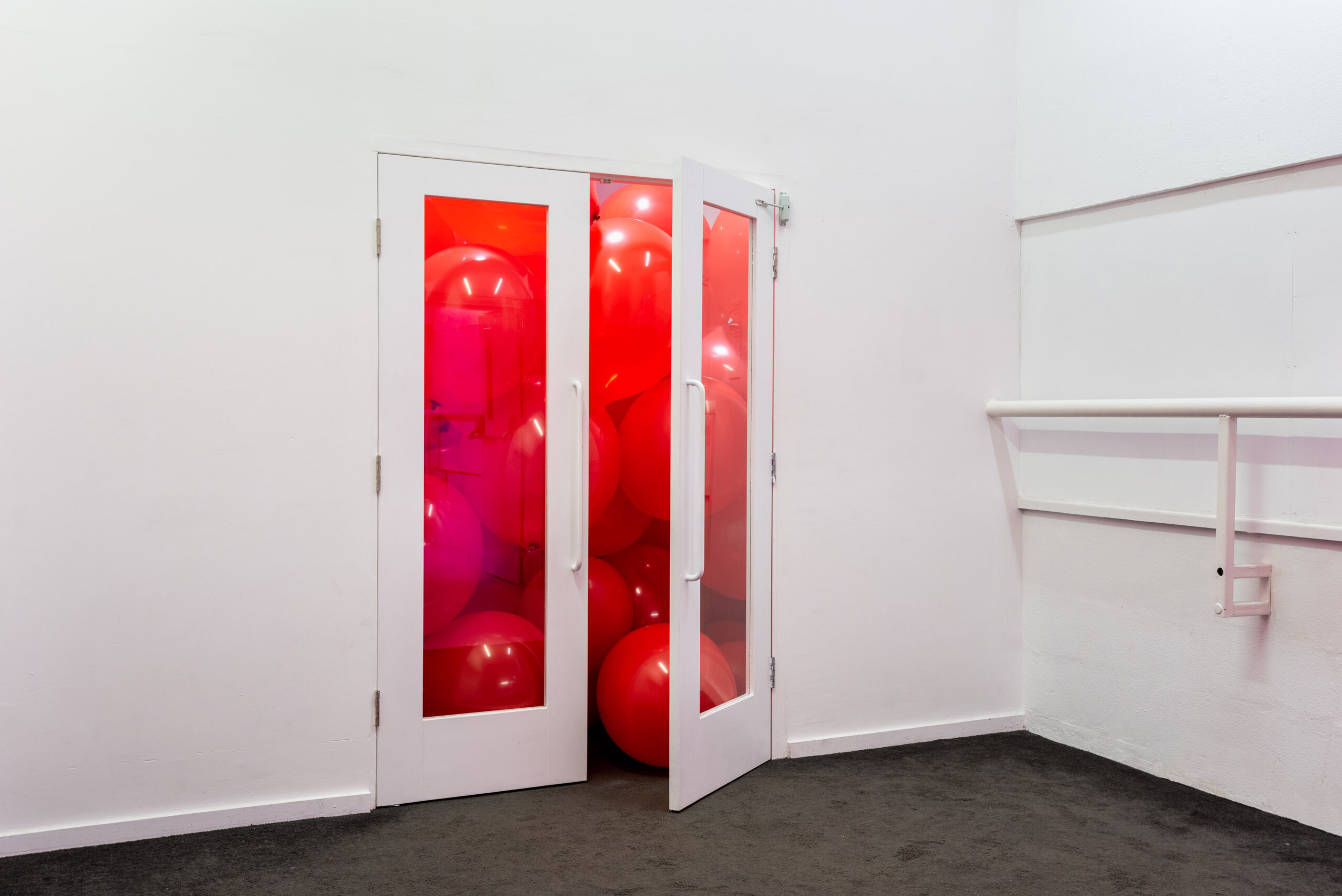
Work No. 2592, Half the air in a given space, 2015
Half the air in a given space is one of Martin Creed’s most celebrated artworks, involving a room in which half of the air is contained within hundreds of coloured balloons. A playful subversion of art and space, visitors are invited to immerse themselves in this marvellous environment.
Martin Creed (b. 1968, Wakefield, UK) lives and works in London.
Courtesy the artist and Hauser & Wirth
Photography by Deniz Guzel
Martin Creed has become known for hugely varied work which is by turns uncompromising, entertaining, shocking and beautiful. Working across a variety of mediums, including installation, music, performance sculpture, video and painting, Creed’s work asks its viewer to question its meaning through the experience of its encounter. Creed has brought heart, soul, and humour to his particular brand of art, and in so doing helped re-contextualise what art is, what it does, and who it is for.
Martin Creed (b. 1968, Wakefield, UK) Lives and works in London and Alicudi. From 1986 to 1990, Creed studied painting at the Slade School of Fine Art. In 2001 Creed was awarded the Turner Prize, and in 2014 the Hayward Gallery in London staged a major retrospective of Creed’s work entitled What’s the Point of It?. In 2019 the Kistefos Museum, Jevnaker, Norway, presented an exhibition entitled Inside Out which paired the work of Creed with that of Howard Hodgkin. Between 2012 and 2018 an Artist Rooms exhibition of Creed’s work toured venues across the UK including Tate Britain, London; Harris Museum and Art Gallery, Preston; Quay Arts, Isle of Wight; Ferens Art Gallery, Hull; and Tate Liverpool, Liverpool. Creed’s works are housed in permanent collections all over the world. Recent solo exhibitions include Centro Botín, Santander, Spain (2019); MARe Museum of Contemporary Art, Bucharest, Romania (2019); Museum Voorlinden, Wassenaar, Netherlands (2017); Qiao Space, Shanghai, China (2016) Kyoto City University Of Arts Art Gallery, Kyoto, Japan (2016); Phoenix Art Museum, Arizona, USA (2016); amongst others. Creed has presented installations in locations as diverse as Braemar Castle, Aberdeenshire, Scotland (2020); Frederica Railway Station, Kolding Library and Vejle Town Hall, Triangle Region, Denmark (2018); Brooklyn Bridge Park, New York (2016); No. 34 Sunridge Avenue, a residential street, Luton, UK (2016) and Guildhall School, London (2013).
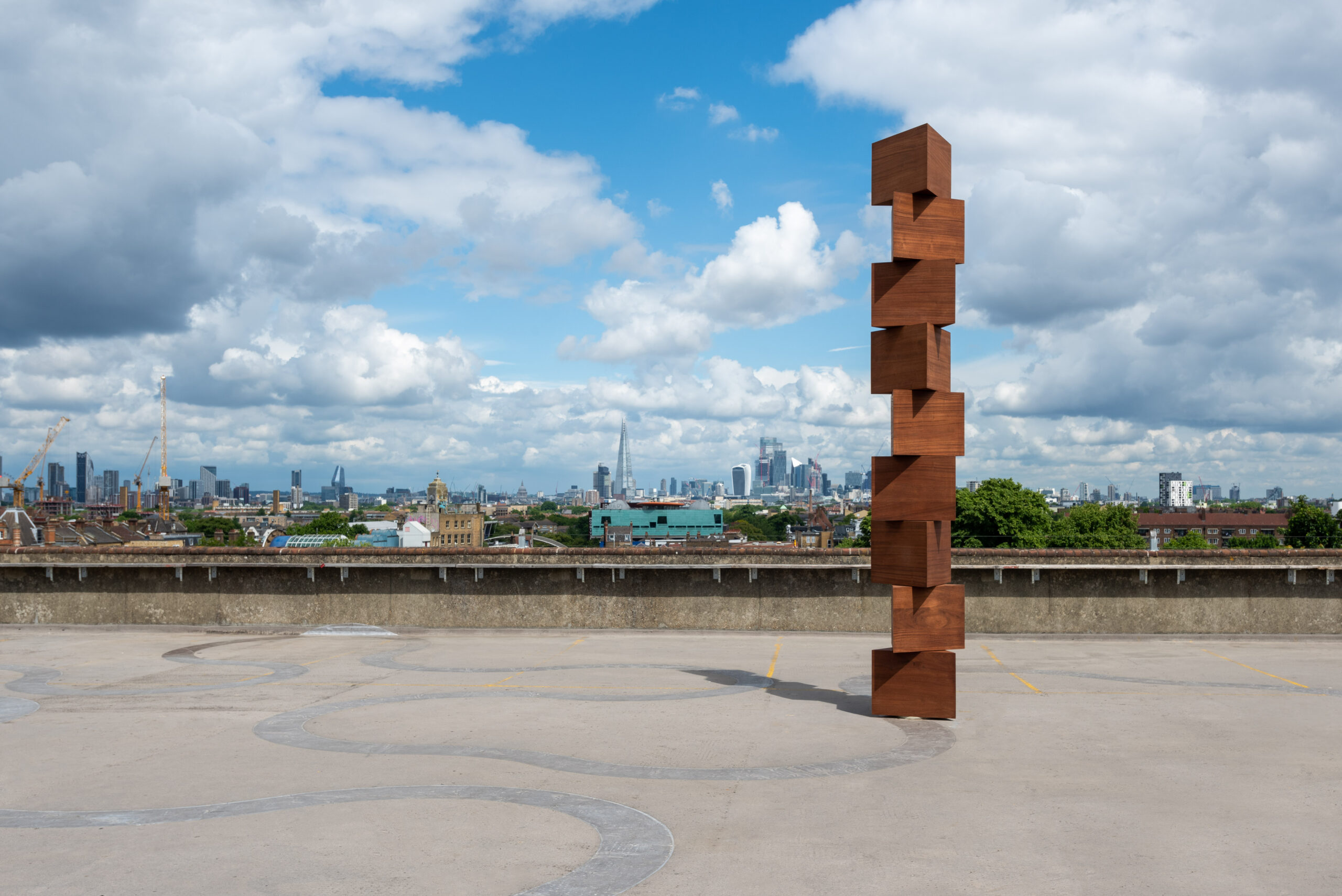
9/3 or I know how to fall (3) and I was born to nights (9), 2022
Taking the scale of a public monument, this sculpture is composed of nine triangular prisms made from African mahogany, rotating to create a bird’s eye view of a nine-pointed star. Referencing Nine Nights that is celebrated in Jamaican culture, where on the ninth night after a person’s death families hold a large celebration to finally see off the spirit, to see off the “duppy.”
Evoking the presence of a number of plinths from which a statue has toppled from, the obelisk abstracts the human body with minimal and rhythmic composition — on the one hand, creating a lyrical expression of the spiritual connection to heaven; on the other, a darker abstraction which calls to mind the trifocal points of the Trans-Atlantic Slave Trade (Africa, The Caribbean and Western Europe), as well as the many slave ships constructed from indigenous African woods.
Through formal and conceptual juxtaposition, the work presents a complex and shifting relationship between history, identity and who and what we choose to memorialise in our society.
Rhea Dillon (b. 1996, London, UK) lives and works in London.
Photography by Deniz Guzel
Rhea Dillon is an artist, writer and poet that questions established rules of representation. Dillon examines the intersections between history and identity by using techniques of conceptualism and abstraction to subvert entrenched layers of meaning. Through this her work centres on the lyrical expression of what constitutes as the ontology of Blackness versus the ontic.
Rhea Dillon (b. 1996, London, UK) lives and works in London. Dillon graduated from Central Saint Martins in 2019 and is a lecturer for Cassandra Press Classrooms. Recent solo exhibitions include Nonbody Nonthing No Thing at V.O Curations, London (2021) and Janus at Soft Opening, London (2021). Selected group exhibitions include Division of Labour, UK (2021); Drawing A Blank, Paris (2020); Almine Rech, London (2020) and Peak Gallery, London (2020). Other projects include Catgut — The Opera, a Serpentine Park Nights Commission, London (2021) and Uchronia et Uchromia, an online net artwork and exhibition commissioned by External Pages (2020). Dillon also founded Lecture Performa, a series that invites artists from across the digital diaspora to engage in natural inquiry and critical thought through lecture-performance. Last year she published her first chapbook of poetry and text, Donald Dahmer. Dillon is currently artist-in-residence at Triangle – Astérides in Marseille until April 2022 and is preparing for her second solo exhibition with Soft Opening in Spring 2022. Her project with Bold Tendencies will be her first public work of art.
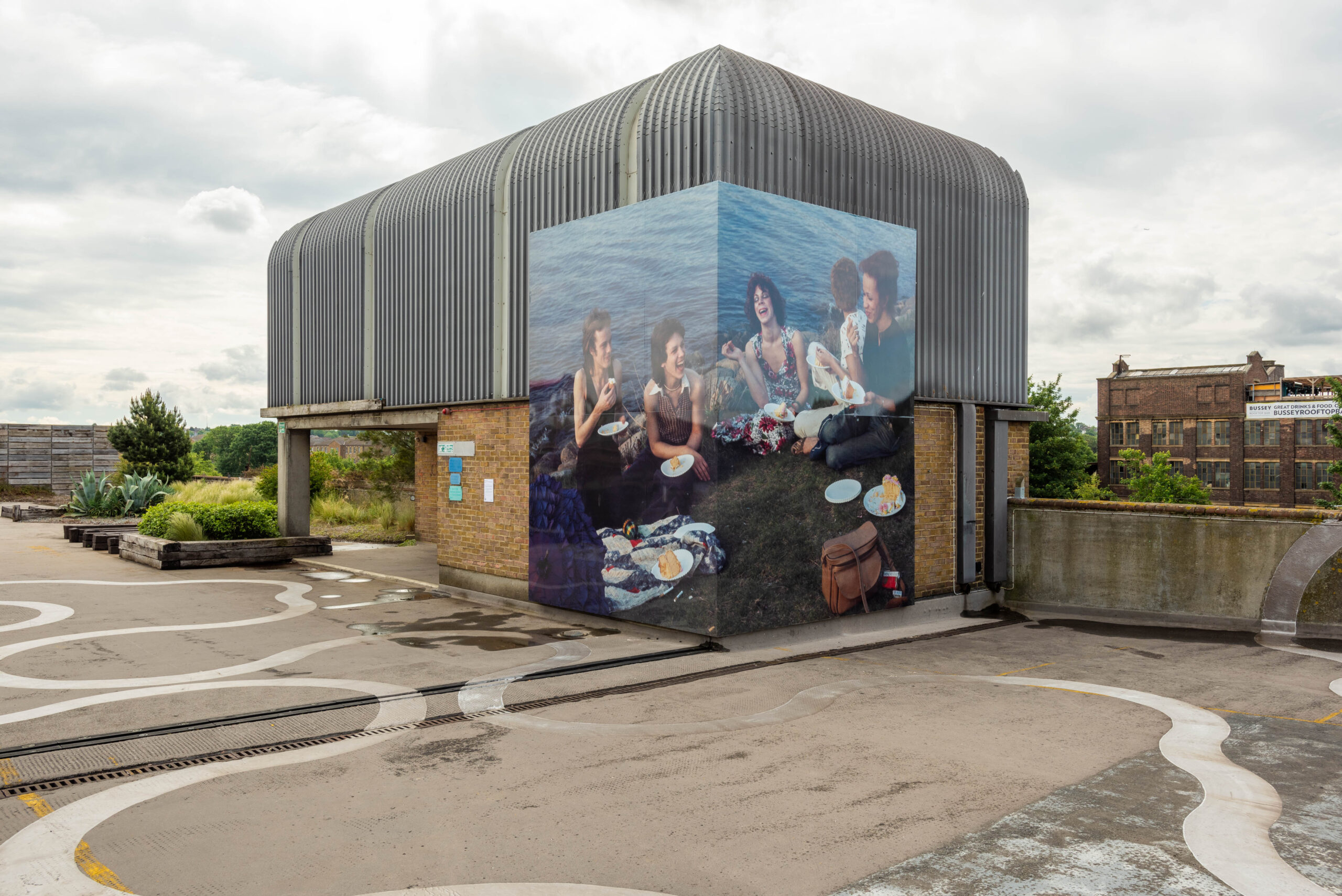
Picnic on the Esplanade, Boston, 1973
“My work has always come from empathy and love.”
Selected from her seminal series of photographs The Other Side, this billboard image is a homage to the extended family of drag queens that the artist lived with during the 1970s, and those she was close to during the 80s and 90s in Boston and New York.
Documenting the glamour and vulnerability of this culture and its participants, Goldin’s work is a celebration of life spent on the margins of society, giving voice to the rebellious and romantic lives they pursued, many of which have been lost over the last four decades.
Picnic on the Esplanade, Boston demonstrates Goldin’s personal and candid approach to photography, capturing the sense of family and love that united the group, joined together through shared beliefs to live life full and for the moment.
Nan Goldin (b. 1953, Washington, US) lives and works in New York, Berlin, and Paris.
With thanks to Nan Goldin Studio and Marian Goodman Gallery.
Photography by Deniz Guzel
Over the last 45 years Nan Goldin has transformed the practice of photography and media art with her honest and deeply personal portraiture, alongside her work with film, music, and archives. She is known for her unflinching approach to the intimacies of love and human relationships, for documenting battles with addiction, loss and dependency, and the nuances of the communities in which she has lived and these experiences have taken place – for many, communities in which another kind of life is possible. Bravely confronting the vicissitudes of her own life and those of the friends and loved ones who surround her, Goldin’s work has explored LGBT bodies and drag culture, the human cost of the HIV crisis and opioid epidemic, and the grave reality of her own personal addictions and tragedies. Balancing spontaneity with beauty, transgression and suffering, her pictures express a profound lyricism and empathy for their subjects.
Nan Goldin (b. 1953, Washington, US) lives and works in New York, Berlin, and Paris. Her work has been the subject of two major touring retrospectives: one organised in 1996 by the Whitney Museum of American Art, New York, and another in 2001, by the Centre Pompidou, Paris, and the Museo Nacional Centro de Arte Reina Sofía, Madrid, which subsequently travelled to London, Porto, Turin, and Warsaw. In 2019, Goldin was commissioned to create new work for the Palace of Versailles exhibition, Versailles – Visible/Invisible. Goldin has been the recipient of numerous awards including the Hasselblad Award in 2007 and was named a Commandeur of the Ordre des Arts et des Lettres in France in 2006. In 2012, Goldin was awarded the prestigious Edward MacDowell Medal, for her outstanding contribution to American culture and the arts. In 2017, Goldin formed the activist group P.A.I.N. (Prescription Addiction Intervention Now), which stages protests aimed at US pharmaceutical drug companies. A major retrospective, focusing exclusively on slideshows and video works, will open at Moderna Museet, Stockholm, in October 2022. Nan will present her archival film work, Sirens, at the Central Pavilion of the 59th Venice Biennale.
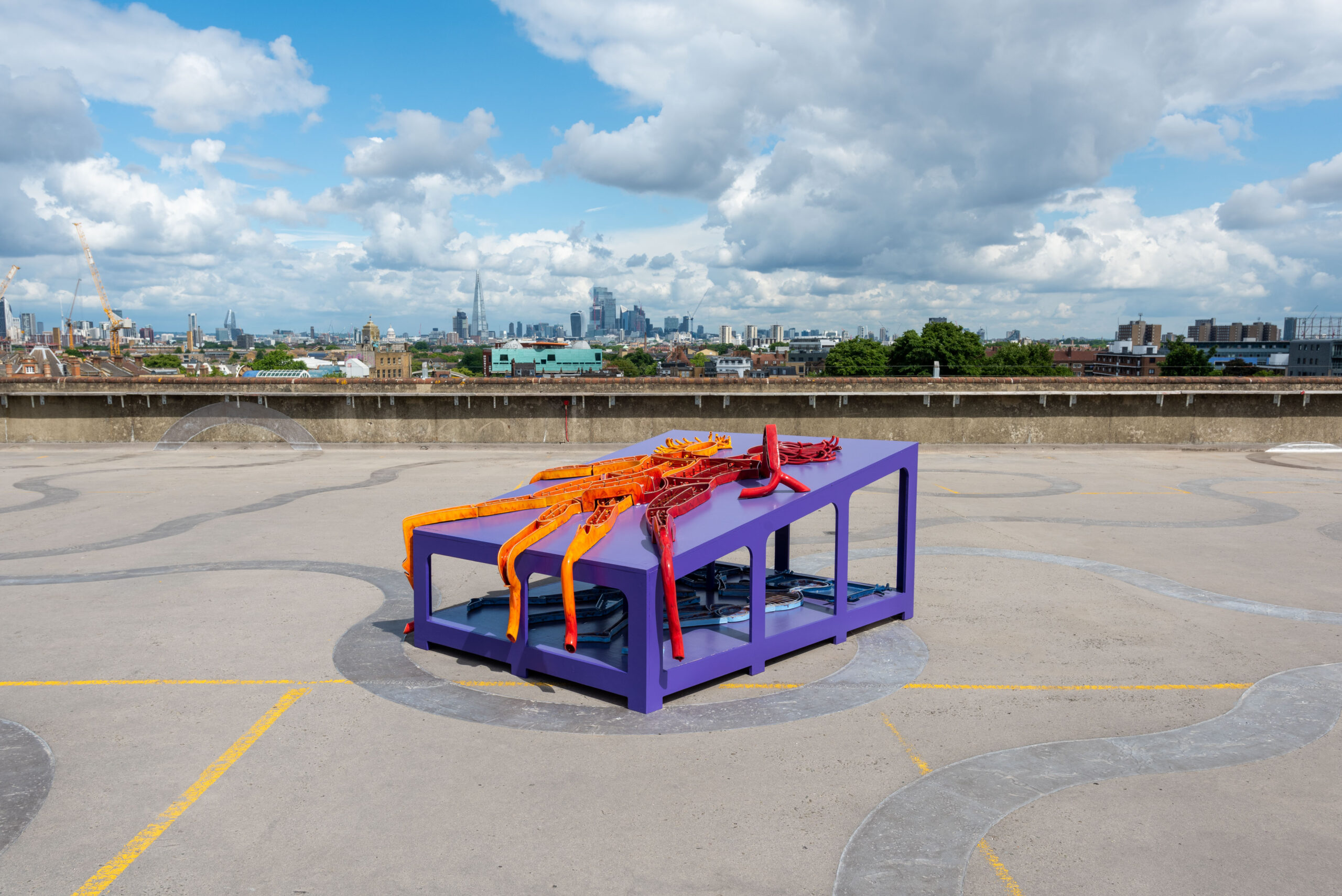
Grief is recognised as a friend, 2022
This ceramic sculpture takes the form of a Late Mediaeval cadaver monument, otherwise known as a transi tomb. Designed to remind its audience of the transience of mortal life, its twin-level format includes a graceful and lifelike depiction of its subject raised above the effigy of a skeleton or an emaciated, even decomposing, dead body.
Here the living figures are abstracted, appearing both mechanical and melting as they merge into one another and towards the dead below. Blurring clear distinctions between the two realms and individual borders, this sculpture explores the connections between love and death, articulated through the profound experiences of loss, grief and mourning.
Echoing the open-face structure of the car park, the solemn purple tomb contains four anatomies that entwine through vibrant form and colour, suggesting the proximity of joy and sorrow, love and tragedy, but also a refusal to allow death to obscure our fondest memories.
Paloma Proudfoot (b. 1992, London, UK) lives and works in London.
Photography by Deniz Guzel
Using a combination of glazed ceramics with glass, metal, custom-tailored clothes and natural materials such as hair, food and wax, Paloma Proudfoot explores a quiet and uneasy paradox between the human body, prosthetics and the myriad apersonal forces that infiltrate and expose our more-than-human lives. Juxtaposing the idiosyncrasies of craftsmanship with the hard-edged rhythms of factory production and soft, biomorphic forms, Proudfoot’s work produces an uncanny realisation of the limits and vulnerabilities of the human body, as well as suggesting the desire one may have to overcome or give into this sensation.
Paloma Proudfoot (b. 1992, London, UK) lives and works in London. Proudfoot received an MA in Sculpture from the Royal College of Art, London. She was recipient of the Micro Residency Award from the Edinburgh Sculpture Workshop in 2017 and the Sculpture Town Artist Award in Harlow in 2018. In 2018, Proudfoot completed the Thun Ceramic Residency, Bolzano, Italy, and in 2019, at the Irish Museum of Modern Art (with Stasis) and Moly Sabata Residency, France. With collaborator Aniela Piasecka, she has also completed residencies at The Work Room in Glasgow (2017 & 2018) and The Tramway, Glasgow (2020). Recent solo and duo exhibitions include TJ Boulting, London (2021); Soy Capitán, Berlin (2021, 2019 & 2018); Editorial, Vilnius (2021); Hannah Barry Gallery, London (2021 and 2018); Sans Titre, Paris (2019); Cob Gallery, London (2018); The Royal Standard, Liverpool (2017); and May Projects, London (2016). As well as her solo sculptural practice, Proudfoot has a number of ongoing collaborations; including with the sculptor Lindsey Mendick; with the artist and choreographer Aniela Piasecka; and with the performance group Stasis.

may they never catch you, 2022
Conceived as a love letter to the Windrush Generation and its descendants, may they never catch you speaks also to the wider Black British community situated in the UK and beyond its borders. Composed of nine cast-iron harpoons that have pierced the car park’s rooftop, the use of nautical imagery relates one experience of being Black in the West to Pauline Gumbs’ allegorical comparison of Blackness as a huntable and sometimes undetectable sea creature.
Depicting the rusting aftermath of a failed hunt or disastrous moment out at sea, may they never catch you is an ode to Blackness’ ability to evade capture, its ongoing resistance and struggle to overcome extractive forms of exploitation and oppression. Further evoking the nine regenerative heads of the Hydra, the installation imagines an aquatic Black Future built upon the destruction of the Ship or the State.
Dominique White (b. 1993, Essex, UK) lives in Marseille and works nomadically.
Photography by Deniz Guzel
Dominique White weaves together theories of Black Subjectivity with myths of the Black Diaspora into a term she defines as the Shipwreck(ed); a reflexive verb and state of being. Using multi-layered iconography that references nautical mythology and insurrectionary politics, her sculptural language depicts the ongoing, cyclical effects of anti-Blackness and (neo)colonialism, imagining a Black futute which pushes beyond its encroaching limitations of Outer Space, reaching deep into the depths of the unknown. Through work that highlights conditions of Afro-pessimism, Hydrarchy and the emergence of the Stateless, White demonstrates the potential for “a [Black] future that hasn’t yet happened, but must.” (Campt 2017 in Yussof 2018).
Dominique White (b. 1993, Essex, UK) lives in Marseille and works nomadically. Recent and upcoming exhibitions include Statements at ArtBasel, Basel (CH) (2022), The Cinders of the Wreck at Triangle – Astérides, Marseille (FR) (2022), Hydra Decapita at VEDA, Florence (IT) (2021); Techno Worlds at Art Quarter Budapest, commissioned by Goethe-Institut (Travelling) (2021-2025) and Blackness in Democracy’s Graveyard at UKS, Oslo (NO) (2021). White was awarded the ad occhi chiusi… prize by Fondazione Merz (Artissima) in 2021 and the Roger Pailhas Prize (Art-O-Rama) in 2019 in conjunction with her solo presentations with VEDA and has received awards from Artangel (UK) and the Henry Moore Foundation (UK) in 2020. White was in residency at Sagrada Mercancía (CL), Triangle France – Astérides (FR) and La Becque (CH) in 2020 and 2021. White’s works can be found in public and private collections in France, Italy and Belgium.
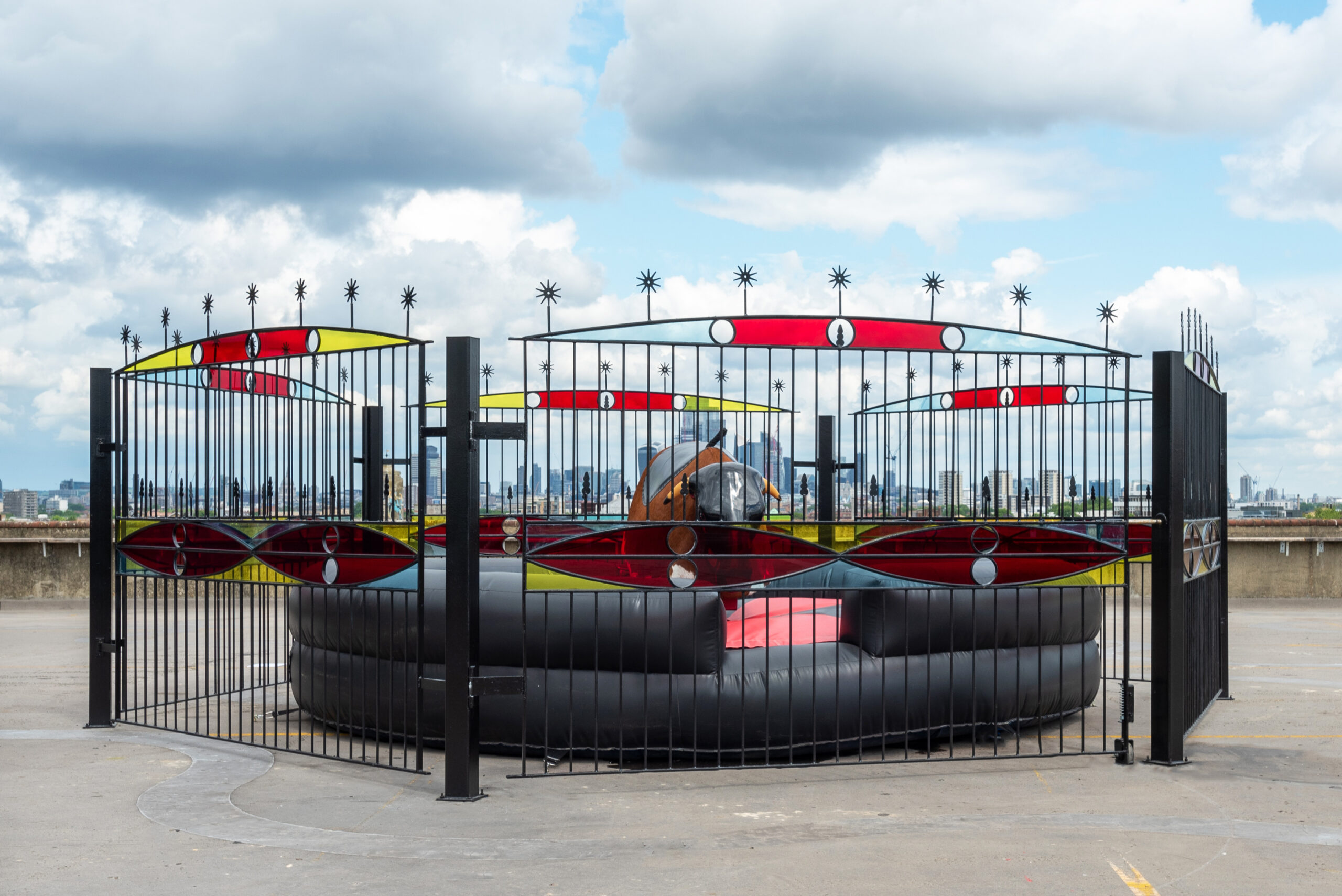
Pain and Glory, 2022
Pain and Glory is an interactive sculpture inspired by the often-guarded, sensual worlds of the underground. The work explores the slippery relationship between domination, spectatorship and performance, encouraging viewers to revel in the thrill and vulnerability of watching and being watched.
Centred around a working mechanical bull enclosed by an ornate bullpen of adorned steel fencing, the sculpture simultaneously obscures and refracts the desiring gaze. In doing so, it evokes veiled spaces such as bars, darkrooms, bathhouses or strip clubs, made precarious by gentrification and policing.
Evoking an exaggerated form of the impulse to love through domination, the machine’s undulating motion points to but also exceeds the erotic. In doing so, it draws comparisons between the repetitive labour of taming across the animal/human divide and subterranean rituals of intimacy and love.
Gray Wielebinski (b. 1991, Dallas, US) lives and works in London and Los Angeles.
Music composed by TWEAKS and SONIKKU.
Photography by Deniz Guzel
Gray Wielebinski uses a multifaceted practice to explore the intersections of mythology with identity, gender, nationhood and memory. Reimagining the dominant myths which structure our society, Wielebinski interrogates the unspoken visual codes that construct social and moral values, focusing on areas such as sport, celebrity culture and costume. Using a combination of video, performance, collage, installation and sculpture, his work highlights the politically charged nature of social mythology and its relationship to power, gender and the human body.
Gray Wielebinski (b. 1991, Dallas, US) lives and works in London and Los Angeles. Wielebinski completed a postgraduate degree from The Slade School of Fine Art in 2018, after having studied at Pomona College in Claremont, California. Recent solo exhibitions include Hales Gallery, London (2021); Gallery 12.26, Dallas (2020); and SEAGER Gallery, London (2019); Selected group exhibitions include Goldsmiths CCA, London (2022); V.O Curations, London (2021); Public Gallery, London (2020); Krefelder Kunstverein, Dusseldorf (2020); Lychee One, London (2019); Turf Projects, London (2018). Wielebinski has completed residencies at City & Guilds London Art School, London (2019); Kaitak Centre for Research and Development AIR, Hong Kong (2018); Agora Collective Residency, Berlin (2015). He is the recipient of the Jeanne Szego Travel Award (2017), The Leonora Carrington Scholarship (2016), Matthew Klopfleisch Memorial Prize in Art (2014) and Mary Drew Art Prize (2013). His work is held in collections at Los Angeles County Museum of Art (LACMA), San Francisco Museum of Modern Art (SFMOMA) and Pomona College Museum of Art.